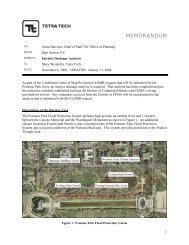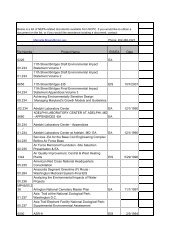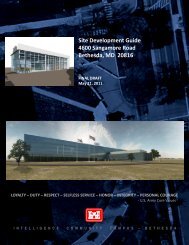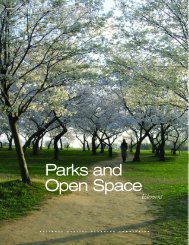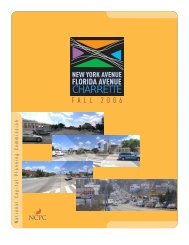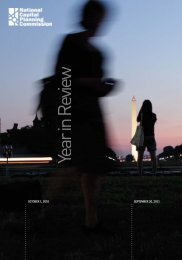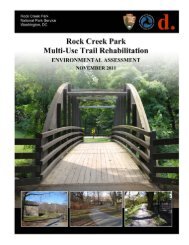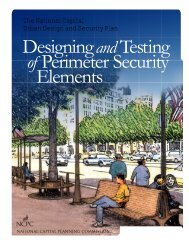The National Capital Urban Design and Security Plan
The National Capital Urban Design and Security Plan
The National Capital Urban Design and Security Plan
You also want an ePaper? Increase the reach of your titles
YUMPU automatically turns print PDFs into web optimized ePapers that Google loves.
<strong>The</strong> <strong>Urban</strong> <strong>Design</strong> <strong>and</strong> <strong>Security</strong> <strong>Plan</strong>:<br />
Lincoln Memorial<br />
WEST END<br />
DOWNTOWN<br />
Washington Monument<br />
Jefferson Memorial<br />
CONSTITUTION AVENUE<br />
PENNSYLVANIA AVENUE IN<br />
FRONT OF THE WHITE HOUSE<br />
PENNSYLVANIA AVENUE<br />
FEDERAL TRIANGLE<br />
THE NATIONAL MALL<br />
INDEPENDENCE AVENUE<br />
MARYLAND AVENUE<br />
SOUTHWEST FEDERAL CENTER<br />
• Provides perimeter security against the threat of bomb-laden vehicles.<br />
• Offers a citywide program that provides both security <strong>and</strong><br />
urban beautification.<br />
• Exp<strong>and</strong>s the palette of attractive street furnishings <strong>and</strong> l<strong>and</strong>scape<br />
treatments that can provide curbside security.<br />
<strong>The</strong> <strong>Plan</strong> is built on an urban design framework that identifies key areas<br />
<strong>and</strong> streets within the Monumental Core <strong>and</strong> recommends solutions that<br />
respond to the unique conditions <strong>and</strong> special character of each precinct.<br />
One size does not fit all <strong>and</strong> while the <strong>Plan</strong> proposes several design<br />
approaches, all share a compatible aesthetic vocabulary that helps knit<br />
together the fabric of Downtown Washington.<br />
<strong>The</strong> <strong>Plan</strong> evolved when in March 2000, Congress authorized the<br />
Commission to establish the Interagency <strong>Security</strong> Task Force to evaluate the<br />
impact of security measures on the historic urban design of Washington’s<br />
Monumental Core. In November 2001, the Commission adopted the task<br />
force’s recommendations contained in a report entitled <strong>Design</strong>ing for <strong>Security</strong> in<br />
the Nation’s <strong>Capital</strong>. Among its recommendations, the report called for the<br />
preparation of an urban design <strong>and</strong> security plan to identify permanent security<br />
<strong>and</strong> streetscape improvements for federal facilities in the Nation’s<br />
<strong>Capital</strong>. <strong>The</strong> <strong>Plan</strong> is the result of a collaborative effort by the <strong>National</strong><br />
<strong>Capital</strong> <strong>Plan</strong>ning Commission, the federal <strong>and</strong> District of Columbia governments,<br />
security agencies, <strong>and</strong> civic <strong>and</strong> business organizations.<br />
<strong>The</strong> <strong>Plan</strong> proposes concepts for special streets <strong>and</strong> areas within the<br />
city’s Monumental Core <strong>and</strong> offers a variety of security solutions<br />
such as hardened street furniture, low plinth walls, planters, bollards,<br />
<strong>and</strong> green curbside hedges with embedded security measures. <strong>The</strong>se<br />
elements can be applied in a variety of ways to meet the security <strong>and</strong><br />
design needs of particular downtown areas.



